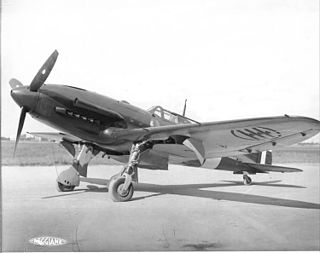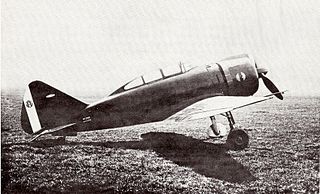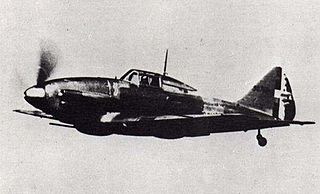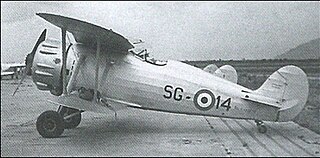Design & Development
Born from the same Regia Aeronautica requirement that spawned the Caproni-Vizzola F.5, FIAT G.50, Macchi C.200, Meridionali Ro 51 and Reggiane Re 2000 fighters, the A.U.T.18 flew for the first time on 22 April 1939, powered by a 1,044 hp (778.51 kW) Fiat A.80 R.C.41 radial engine. The fighter had an all-metal stressed-skin structure, covered in duralumin, featuring an inwardly-retracting undercarriage and retractable tail-wheel and was armed with two 12.7 mm (0.500 in) Breda-SAFAT machine-guns mounted in the wings just outboard of the undercarriage.
Flight trials proved disappointing and lagged behind the other fighters in Progetto R - the modernisation (riammodernamento) of the Regia Aeronautica. With no production orders forthcoming, despite the prototype being returned to the Umbra factory at Foligno for modifications on 20 February 1940 and a second flight test series from 5 November 1940, no improvement was demonstrated over fighters already in production so the A.U.T.18 was abandoned.

The Macchi C.200 Saetta, or MC.200, was a fighter aircraft developed and manufactured by Aeronautica Macchi in Italy. Various versions were flown by the Regia Aeronautica who used the type throughout the Second World War.

The Macchi C.202 Folgore was an Italian fighter aircraft developed and manufactured by Macchi Aeronautica. It was operated mainly by the Regia Aeronautica in and around the Second World War. According to aviation author David Mondey, the Folgore has been considered to be one of the best wartime fighters to serve in large numbers with the Regia Aeronautica.

The Fiat CR.32 was an Italian biplane fighter used in the Spanish Civil War and World War II. Designed by the aeronautical engineer Celestino Rosatelli, it was a compact, robust and highly manoeuvrable aircraft for its era, leading to it being a relatively popular fighter during the 1930s.

The Fiat G.55 Centauro was a single-engine single-seat World War II fighter aircraft used by the Regia Aeronautica and the Aeronautica Nazionale Repubblicana in 1943–1945. It was designed and built in Turin by Fiat. The Fiat G.55 was arguably the best type produced in Italy during World War II, but it did not enter production until 1943, when, after comparative tests against the Messerschmitt Bf 109G and the Focke-Wulf 190, the Luftwaffe itself regarded the Fiat G.55 as "the best Axis fighter".

The Breda Ba.88 Lince ("Lynx") was a ground-attack aircraft used by the Italian Regia Aeronautica during World War II. Its streamlined design and retractable undercarriage were advanced for the time, and after its debut in 1937 the aircraft established several world speed records. However, when military equipment was installed on production examples, problems of instability developed and the aeroplane's general performance deteriorated. Eventually its operational career was cut short, and the remaining Ba.88 airframes were used as fixed installations on airfields to mislead enemy reconnaissance. It represented, perhaps, the most remarkable failure of any operational aircraft to see service in World War II.

The Breda Ba.65 was an Italian all-metal single-engine, low-wing monoplane used by Aviazione Legionaria during the Spanish Civil War and Regia Aeronautica in the first half of World War II. It was the only Italian ground-attack aircraft that saw active service in this role. It saw service almost exclusively in the North African and Middle-Eastern theatre. In addition to more than 150 aircraft operated by the Italian forces, a total of 55 were exported and used by the air forces of Iraq, Chile and Portugal.

The Reggiane Re.2005 Sagittario was an Italian monoplane fighter and fighter-bomber produced for the Regia Aeronautica during the later years of World War II. Along with the Macchi C.202/C.205 and Fiat G.55, the Reggiane Re.2005 was one of the three Serie 5 Italian fighters. The lines of the fuselage were aerodynamically efficient, and the design was intended to exploit the famous Daimler-Benz DB 605 engine. The only drawback was a certain structural weakness in the rear section of the fuselage. Only 48 examples had been delivered before the Armistice, and these fighters took part in the defence of Naples, Rome and Sicily, with the survivors battling above the crumbling ruins of Berlin, in German insignia. British ace and military observer, Group Captain Duncan Smith, DSO DFC, said that "The Re.2005 was altogether a superb, potent aeroplane".

The Reggiane Re.2000 Falco I was an Italian all metal, low-wing monoplane developed and manufactured by aircraft company Reggiane. The type was used by the Regia Aeronautica and the Swedish Air Force during the first part of the Second World War.

The Reggiane Re.2001 Falco II was an Italian fighter aircraft, serving in the Regia Aeronautica during World War II. A contemporary of the renowned Macchi C.202, the production of this type was to be limited to only 252, but it was a flexible design that proved to be able to undertake a number of roles. Thanks to its maneuverability it could dogfight with more powerful opponents like the Supermarine Spitfire. The Re.2001 became the basis of a later, more formidable fighter, the Re.2005.
Breda-SAFAT was an Italian weapons manufacturer of the 1930s and 1940s that designed and produced a range of machine-guns and cannon primarily for use in aircraft. Based on the M1919 Browning machine gun, the Italian guns were chambered to fire indigenous ammunition with 7.7 mm (0.303 in) and 12.7 mm (0.500 in) calibres, predominantly ball, tracer for the 7.7mm, including high explosive incendiary tracer (HEI-T), or armour-piercing (AP) for the 12.7mm.

The Fiat CR.25 was an Italian twin-engine reconnaissance-fighter aircraft which served in small numbers for the Regia Aeronautica during World War II.

The Reggiane Re.2002 Ariete ("Ram") was an Italian fighter-bomber developed during World War II. The aircraft was a further development of the Re.2000, with some of the modifications that already had been introduced in the Re.2001. The aircraft was mainly used by the Regia Aeronautica, but it also saw limited use with the German Luftwaffe, who used it against the French resistance.

The CRDA CANT Z.1018 Leone (Lion) was an Italian medium bomber of the 1940s.

The Breda Ba.201 was an Italian dive bomber designed during World War II, that never entered production.

The Caproni Vizzola F.5 was an Italian fighter aircraft that was built by Caproni. It was a single-seat, low-wing cantilever monoplane with retractable landing gear.

The IMAM Ro.41 was an Italian light biplane fighter aircraft, serving in the Regia Aeronautica in the 1930s-1940s, mainly as a trainer.

The Piaggio P.119 was an Italian experimental fighter of World War II. It had a relatively novel layout, with a "buried" radial engine mounted mid-fuselage. Only a single prototype was built before the Armistice between Italy and the allied armed forces, which ended the project.

The IMAM Ro.51 was an Italian fighter aircraft that first flew in 1937. It was designed for the 1936 new fighter contest for the Regia Aeronautica, with practically all the Italian aircraft builders involved.

The IMAM Ro.57 was an Italian twin-engined, single-seat monoplane fighter of the Regia Aeronautica. Based on a 1939 design by Giovanni Galasso the aircraft did not enter production until 1943.

The Caproni Vizzola F.6 was a World War II-era Italian fighter aircraft built by Caproni. It was a single-seat, low-wing cantilever monoplane with retractable landing gear. Only two prototypes were built, one designated F.6M and the other designated F.6Z.



















